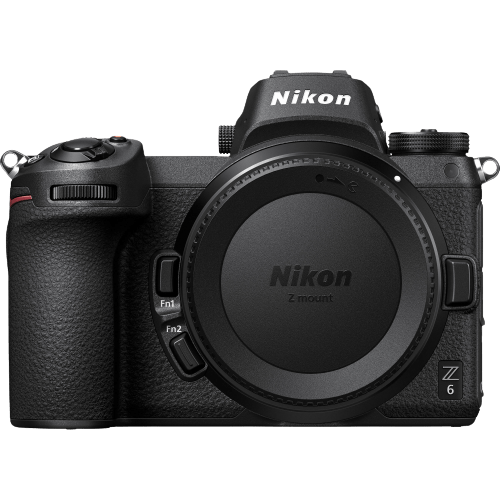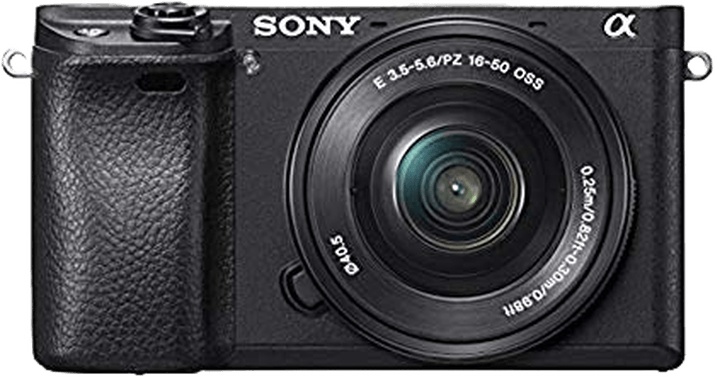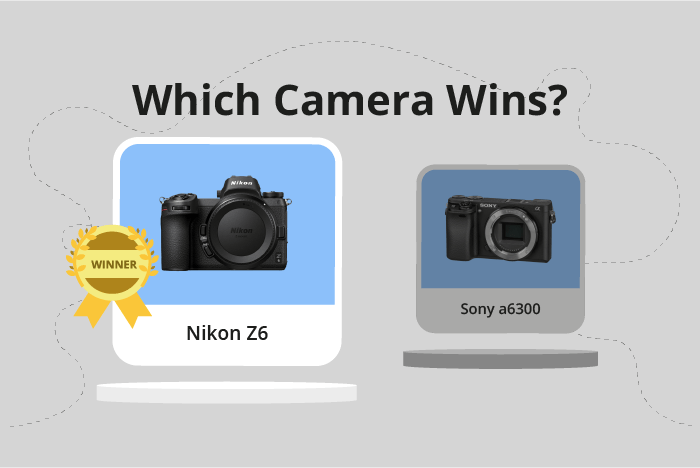Nikon Z6 vs Sony a6300 Comparison
Nikon Z6

Sony a6300

The Nikon Z6 outperforms the Sony a6300 with a score of 81/100 compared to the Sony’s 61/100. Both are mirrorless cameras, announced in 2018 and 2016 respectively. They share similarities in size and weight, with the Nikon Z6 measuring 134 x 101 x 68mm and weighing 675g, while the Sony a6300 is slightly smaller and lighter at 120 x 67 x 49mm and 404g.
The Nikon Z6 excels with its higher launch price of $2000, signifying a more advanced camera. However, the Sony a6300 has an advantage in affordability with a launch price of $1000, making it more accessible to a wider range of photographers.
Considering these factors, the Nikon Z6 is a superior camera for those seeking better performance, while the Sony a6300 is a more budget-friendly option for photographers who prioritize affordability.
Nikon Z6 vs Sony a6300 Overview and Optics
The Nikon Z6 outperforms the Sony a6300 in optics with a score of 83/100, compared to the Sony a6300’s score of 68/100. Both cameras possess 24-megapixel CMOS sensors and similar shooting speeds, with the Nikon Z6 at 12 fps and the Sony a6300 at 11 fps. Additionally, both cameras use different processors, with the Nikon Z6 utilizing the Expeed 6 and the Sony a6300 using the Bionz X.
The Nikon Z6 excels in several aspects, including a higher DXOMARK sensor score of 95 as opposed to the Sony a6300’s score of 85. The Z6 also boasts a full-frame sensor, while the a6300 has an APS-C sensor. This difference results in superior image quality and low-light performance for the Nikon Z6. Furthermore, the Z6 features a Nikon Z lens mount and built-in image stabilization, which enhances image sharpness and reduces the impact of camera shake.
Despite its lower score, the Sony a6300 has some advantages, such as a smaller body and a wider range of compatible lenses due to its Sony E lens mount. However, it lacks image stabilization, which may be a drawback for some photographers.
To sum up, the Nikon Z6 surpasses the Sony a6300 in terms of optics, with a higher DXOMARK sensor score, full-frame sensor, and built-in image stabilization. These features contribute to its overall superior image quality. On the other hand, the Sony a6300 offers a more compact design and wider lens compatibility but falls short in stabilization and sensor performance.
Nikon Z6 vs Sony a6300 Video Performance
The Sony a6300 emerges as the winner in terms of video capabilities, scoring 91/100 compared to the Nikon Z6’s 83/100. Both cameras have a maximum video resolution of 4K and dimensions of 3840 x 2160. Additionally, both cameras come with built-in time-lapse functionality.
The Sony a6300 outshines the Nikon Z6 with its maximum video frame rate of 120fps, doubling the Z6’s 60fps. This higher frame rate enables the a6300 to capture smoother slow-motion footage, making it more suitable for action and sports videography.
On the other hand, the Nikon Z6 has some advantages over the Sony a6300. Although not specified, the Z6 may offer better low-light performance and a more extensive selection of video features. However, these advantages do not outweigh the Sony a6300’s superior frame rate.
Considering the video capabilities of both cameras, it is evident that the Sony a6300 is the better choice for videographers seeking smooth slow-motion footage, while the Nikon Z6 may be more suitable for those who prioritize low-light performance and additional video features.
Nikon Z6 vs Sony a6300 Features and Benefits
The Nikon Z6 outperforms the Sony a6300 with a feature score of 87/100, compared to the Sony a6300’s score of 54/100. Both cameras share some common specifications, such as the absence of GPS and the presence of WIFI connectivity.
The Nikon Z6 excels with its 3.2-inch screen size and a superior resolution of 2,100,000 dots, providing a clearer and larger display for users. Additionally, the Z6 offers a touchscreen feature, enabling more intuitive control and ease of use. The camera also has bluetooth connectivity, allowing seamless transfer of images and remote control options.
On the other hand, the Sony a6300 has a flip screen, which the Nikon Z6 lacks. This can be an advantage for those seeking flexibility in shooting angles or capturing self-portraits. However, the a6300’s screen measures 3 inches with a lower resolution of 921,600 dots, and it does not have a touchscreen. Furthermore, the Sony a6300 does not offer bluetooth connectivity.
Considering these points, the Nikon Z6 proves to be a better camera in terms of features, with a larger and higher resolution screen, touchscreen capabilities, and bluetooth connectivity. The Sony a6300’s flip screen is its only advantage over the Z6, but this may not be enough to outweigh the benefits offered by the Nikon Z6. Therefore, the Nikon Z6 is the clear winner in this comparison, providing a more comprehensive and user-friendly experience for photographers.
Nikon Z6 vs Sony a6300 Storage and Battery
The Nikon Z6 outperforms the Sony a6300 in storage and battery with a score of 35/100 compared to the a6300’s 24/100. Both cameras have one memory card slot, but the Z6 accepts XQD cards while the a6300 uses SD, SDHC, and SDXC cards. The Z6 has a battery life of 310 shots with its EN-EL15b battery and offers USB charging. The a6300 lasts for 400 shots on its NP-FW50 battery but lacks USB charging capabilities.
The Z6’s use of XQD cards enhances its performance with faster read and write speeds compared to the a6300’s SD card options. Additionally, USB charging increases the Z6’s convenience and versatility for on-the-go charging.
However, the a6300 has a longer battery life, allowing for 400 shots compared to the Z6’s 310 shots. This advantage benefits photographers who require extended shooting periods without access to charging.
Despite the a6300’s longer battery life, the Nikon Z6’s storage and battery advantages, such as the use of XQD cards and USB charging, make it the superior choice in this comparison.
Nikon Z6 vs Sony a6300 – Our Verdict
Are you still undecided about which camera is right for you? Have a look at these popular comparisons that feature the Nikon Z6 or the Sony a6300:

